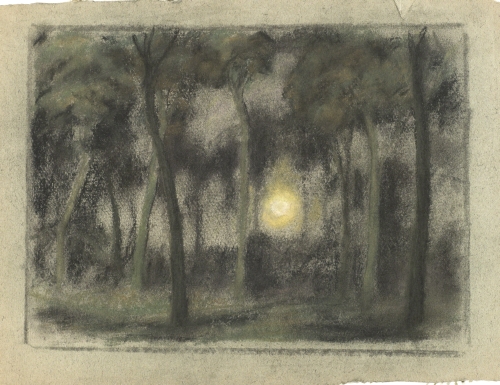African American History Month 2013: Edward Mitchell Bannister
In art history, generally, we tend to regard African American art as having its first significant period during the Harlem Renaissance (ca. 1918–1935). Like many periods in art history—just as with women artists—African American artists tend to be overlooked before the late 1800s. Edward Mitchell Bannister is one of those artists I feel is greatly underappreciated. We just acquired this little gem from the Brooklyn Museum. It is so gorgeous. I’m “over the moon” about it, because I have never quite been able to master pastels. I love the nuances of shading and tone. It is so evocative of a hot summer evening, something which I am longing for right about now!
 |
| Edward Mitchell Bannister (1828–1901, Canada/United States), Untitled, ca. 1885. Pastel on paper, 7 1/2" x 10 1/2" (19.1 x 26.7 cm). © Brooklyn Museum, Brooklyn, NY. (BMA-3150) |
While I often consider Bannister to be part of the romantic realism of 1800s landscape painting, he is clearly a unique artist. Born in New Brunswick, Canada (which abolished slavery in 1830), he received a better education and had more opportunities than blacks in the United States at the time. He was interested in drawing and painting from an early age and in the 1830s visited New York and Boston, seeking out museums and galleries. It was during these trips that he became acquainted with European painting.
Bannister’s mature style was influenced by the French Barbizon painters, a movement that emphasized the spiritual power of nature and use of naturalistic light. He was introduced to this style by the artist William Morris Hunt (1824–1879), who was a close friend to the French Barbizon painter Jean-Francois Millet (1814–1875). The romantic-realist element of Bannister’s work is clearly evident in this lovely little piece. He produced primarily landscapes and regarded nature as a sacred space, never feeling confident in painting the human figure.
Although Bannister suffered prejudice like other African Americans of the time, he lived in Boston and Providence, both liberal centers of abolitionism, where he found greater acceptance as an artist. In 1876 he was the first African American to win a bronze medal from the National Academy in New York. In 1880 he helped form the Providence Art Club, many of whose members were the first faculty of the Rhode Island School of Design.
Check out more works by Bannister at the Smithsonian American Art Museum. I’ve got to say, a lot of his work reminds me of the English Romantic landscape painter John Constable (1776–1837)!
Studio activity: Draw an expressive tree. Using pastel or charcoal, draw a tree with dramatic impact, be it on a dark night with moonlight, or a gnarly tree in daylight. Explore the possibilities of darks and lights on the trunk of the tree and in the branches with the two suggested media. Remember to vary the amount of pressure used with the medium to achieve effects of dark and light. Use a paper towel over the finger to blend areas and achieve smooth transitions between dark and light.
Correlations to Davis programs: Explorations in Art Grade 2: 1.4; Explorations in Art Grade 4: 1.4, 1.6, 6.33; Explorations in Art Grade 6: 5.26; Exploring Visual Design: 1, 3, 5, 6, 9


Comments